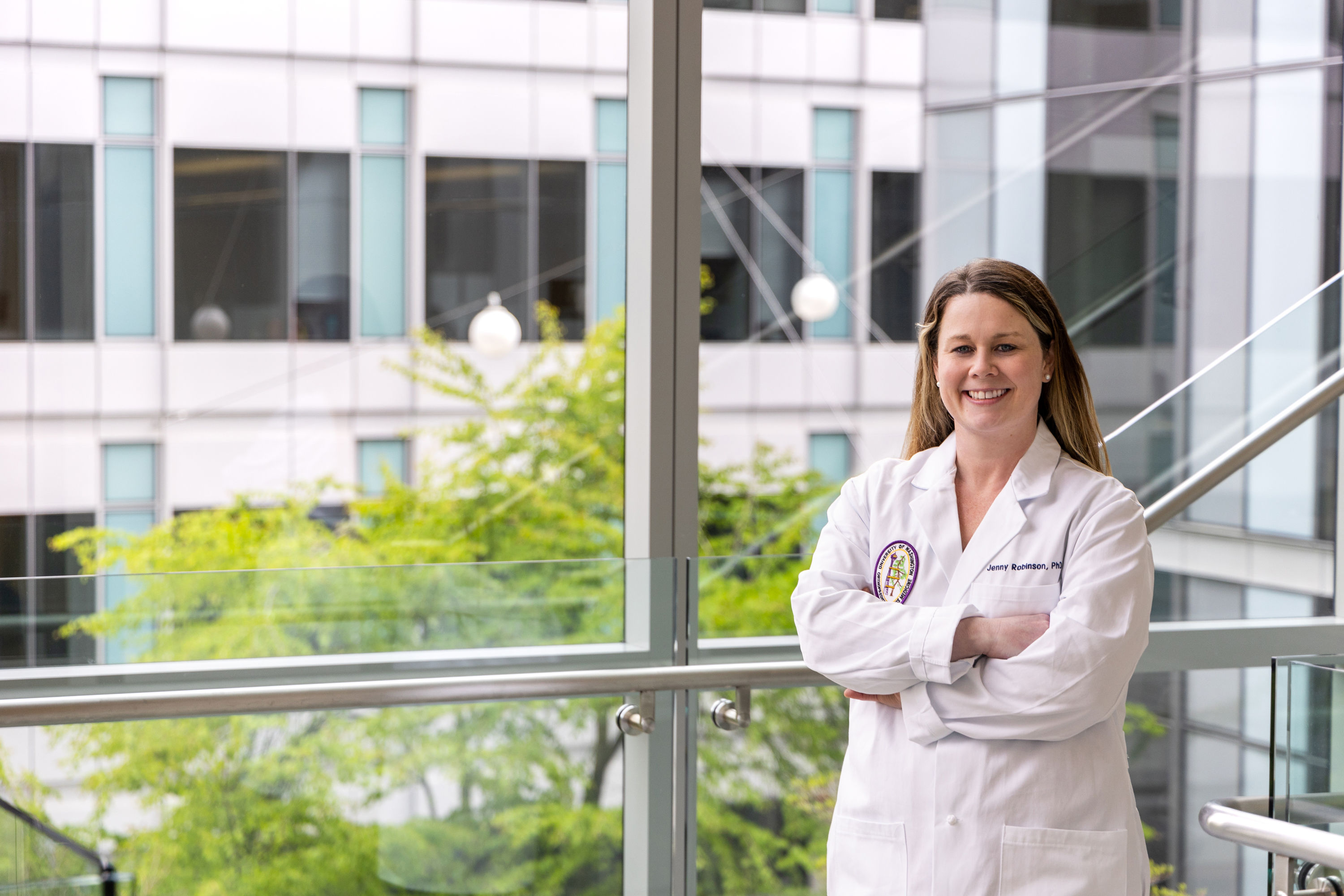
At age 12, Jenny Robinson, PhD, always dreamed of being a professional soccer player. But when she tore her anterior cruciate ligament (ACL) and lateral meniscus, she developed a new interest in how the body works. Today, she is the endowed chair in Women’s Sports Medicine and Lifetime Fitness in UW Medicine’s Department of Orthopaedics and Sports Medicine and assistant professor in the Department of Mechanical Engineering.
“At that age, I didn’t know much, but I was fascinated that there were options to repair my knee,” she reflects. “The doctors took my hamstring tendon and transplanted it into my knee, and they removed part of my meniscus. I could still play, but it led to other problems.”
At 16, doctors diagnosed Robinson with posttraumatic osteoarthritis and recommended she give up soccer completely. She didn’t, but her condition put her on a path to becoming a biomedical engineer dedicated to investigating the role cell and tissue regeneration can play in sports injury recovery.
“In high school, I was very into engineering, and I liked to take things apart and put them back together — to understand how they functioned,” she says. “And, with my injury, I was fascinated by how we could potentially use engineering to promote regeneration.”
Beginning the search for the secrets of cell regeneration
Throughout her undergraduate and doctoral studies, Robinson, most recently at the University of Kansas, concentrated on tissue engineering, a specific area of bioengineering that seeks to restore or improve damaged or non-functional tissues. During this time, she built 3D environments out of polymer-based biomaterials that mimicked various orthopaedic conditions in tissues to figure out what those tissues needed for regeneration.
During her post-doctoral studies, she took this research a step further when she partnered with an advisor interested in improving jaw pain in women. To reach their goal, they delivered estrogen treatment to female mice that had their ovaries removed.
“We looked at how estrogen impacted the properties of bone and cartilage, as well as the cues the cells received for regeneration after injury,” she says.
As a result of this therapy, the mice began to produce more collagens, the major component of the skeleton. This finding sparked Robinson’s interest, and she held onto it for future research.
Looking at mechanical change
Today, as a core faculty member in the Institute for Stem Cell and Regenerative Medicine (ISCRM), Robinson’s childhood interest in how the body works has come full circle. She and her team engineer biomaterial scaffolds to determine the cues that cells involved in the regeneration process need to trigger and jumpstart regeneration after injury.
Inspired by her soccer injury, her team addresses meniscal injuries of the knee that can lead to osteoarthritis. Currently, little research exists in this area of meniscus regeneration, and, for younger patients, removing a portion of the meniscus or suturing the torn pieces together is frequently the go-to treatment. There’s also no FDA-approved, biomaterial available to support, Robinson says.
The long-term complication of meniscal tears is the development of osteoarthritis. Thus, there is a critical need for biomaterials to aid in the healing of meniscal injuries.
Her team bases their research on stem cells and meniscus cells collected from patients between ages 12 and 19 who have experienced a sports injury. The team then uses two different biomaterial fabrication techniques to understand the cues needed for tissue regeneration.
First, they use a technique called electrospinning during which an electric field is applied to polymer solutions to draw out nanometer to micron-sized fibers with tunable properties that resemble the knee’s original collagen fibers. By manipulating the characteristics of the fibers, they can mimic and study various tissue injuries. Additionally, they create hydrogels that imitate many properties of the native meniscus and examine how changing the properties of the hydrogels affects the regenerative properties of native meniscus cells and adult stem cells.
The team is also pursuing a continuation of Robinson’s post-doctoral work, specifically analyzing how men and women respond differently to estrogen treatment after injury. Estrogen promotes the growth of new cells and likely regulates break down, clean up and remodeling of tissue after injury.
“We know estrogen is important to every tissue in males and females,” she says, “but we’re starting to figure out that, biologically, sensitivity differences may drive different responses.”
The potential benefit of this research is two-fold. Knowing how estrogen affects the body, providers may first be able to help female athletes avoid injury during certain times of their menstrual cycle. In addition, a better understanding of the biology may also provide more patient-specific treatment options and improve physical therapy.
“The idea is certain treatments potentially can be sex-dependent or age-dependent,” Robinson says. “It will likely open the door for more personalized treatment.”
The importance of collaboration
As a core ISCRM faculty member, Robinson blends her passions for orthopedics and bioengineering. Since joining only a few months ago, she’s already had the opportunity to partner with multiple faculty members.
“The collaborative discussions are exciting. In discussions with clinical faculty, I can talk with them about their concerns and better understand the clinical problems. Then, I use my engineering knowledge to design a model where we mimic the problem in the body,” she says. “After that, we can study the stem cell biology to see what the cells are doing and decide next steps to take.”
Robinson bolsters her success with her interdisciplinary training and frequently thinks of herself as a translator. As someone who understands the jargon used by cell biologists, engineers and clinicians, she can broker conversations that lead to effective solutions.
Ultimately, Robinson says, her work could help the regenerative medicine field overcome one of its greatest hurdles — the innate complexity of the body and the uniqueness of the cells that make it up. She hopes her research will promote better health and better treatments for patients, including young female soccer players who dream of playing for the U.S. Women’s National Team much like she did.